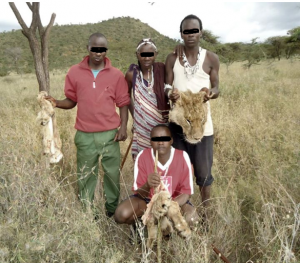News
Latest Lion Aid News
"Chasing what is already gone"
Tuesday 3rd July 2012
|
This is the title of a recent song by Mary Carpenter, a wonderful performer/artist. Does it pertain to conservation? Take a look at the IUCN Red List. Sadly, the overwhelming majority of those species on the Critically Endangered list have no future. The IUCN is good at making lists, but performs poorly in terms of taking positive action. The IUCN has lots of Specialist Groups to draw up these lists, but that seems the sum total of their responsibility. You might well say that you have never heard of the Oxapampa Poison Frog or the Tai Toad. It could well be that their extinction means little to you. We evaluate what is important to us with anthropomorphic bias, but even then there is no guarantee that we are not chasing what has already gone. We have ignored the plight of many species that share our planet for too long for any meaningful recovery – or put our faith in stewardship by organisations that have not delivered? Let’s look at the charismatic megaspecies. Orangutans, Mountain Gorillas, Bonobo Chimpanzees – all gasping their last breaths. The Javan Rhinoceros is virtually extinct, the Vietnamese Rhinoceros is extinct along with the Western Black Rhinoceros and the Northern White Rhinoceros. Among the nine subspecies of tiger, four (Bali, Caspian, Javan, South China) are extinct, three (Sumatran, Malaysian, Indochina) are critically endangered, and two (Bengal and Siberian) might perhaps have some viability. A recent donor conference “pledged” £250 million to once again save tigers – that is what experts said was now needed despite WWF's work to try and save them via “Project Tiger” since 1972. Polar bears, Panda bears, Sun Bears… you know what is happening. In the 1960’s there might have been 200,000 lions on the African continent. There could only be 20,000 now. Trophy hunting, human/livestock conflict, habitat loss, prey loss and diseases have all contributed. Genetically unique lions in western Africa might be down to about 800 individuals, probably a lot fewer. They still have not been listed by the IUCN as Critically Endangered, CITES still allows trade, WWF supports wild lion hunting under certain conditions… Lions are on the brink, not yet over the edge. Time is running out – the hourglass is almost empty, but it can be refilled. We need functional protected areas, a determination by lion range States, a much better evaluation of the “sustainability” of trophy hunting, no more exports from South Africa of lion bones to Asia, and a big wake-up call for the world. Otherwise we will be chasing what is already gone once again for yet another species. Your funding support can make this happen - please consider LionAid. Click here to see the many ways you can donate to LionAid. Picture credit: Big Life Foundation, Tanzania Tags: Hunting, lions, CITES, IUCN, extinction, endangered, critically endangered, Categories: Extinction, Population declines |
Posted by Pieter Kat at 15:31
No comments have been posted yet.
Add a new comment
Existing user
New user sign up




